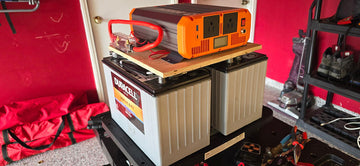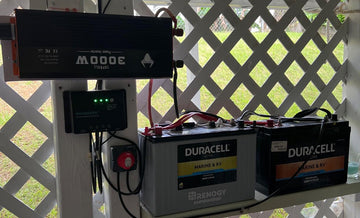We sometimes encounter lithium batteries can not be charged, which not only affects the daily use of equipment, but also may lead to unnecessary troubles. In this article, we will discuss the reasons why lithium batteries do not charge, and provide effective troubleshooting methods to help readers better solve this problem!
Charging of lithium batteries under normal conditions
Charging Principle
The charging principle of lithium battery is that lithium ions detach from the positive electrode material, move to the negative electrode through the electrolyte and embedded in it, and at the same time, the electrons flow from the positive electrode to the negative electrode through the external circuit, forming charging current. When discharging, the process is opposite, lithium ions return to the positive electrode from the negative electrode, while electrons flow from the negative electrode to the positive electrode through the external circuit, forming a discharge current.
The range of normal charging time for lithium batteries
The range of normal charging time for lithium batteries varies depending on factors such as battery type, capacity and charger power.
lithium batteries for RV
- Charging time range: 2 hours to 10 hours
- Note: The capacity of RV lithium batteries is usually between 100Ah and 300Ah, the exact charging time depends on the power of the charger and the initial state of charge of the battery. Charging time can be shortened when using a high power charger (e.g. 30A or higher).
Home storage lithium batteries
- Charging time range: 4 hours to 12 hours
- Description: Li-ion batteries for home energy storage systems typically have a capacity of between 5kWh and 20kWh. The charging time depends on the output power of the photovoltaic system or the charging power of the grid supply. Charging times can be reduced by using a higher power charger or PV inverter.
Marine deep-cycle lithium batteries
- Charging time range: 3 hours to 8 hours
- Description: Marine Li-Ion batteries usually have a capacity between 100Ah and 400Ah. Charging time is affected by charger power and battery condition.
Other applications (e.g. power tools, drones, etc.)
- Charging time range: 1 hour to 4 hours
- Description: Li-ion batteries for these devices usually have smaller capacity (several hundred mAh to several thousand mAh) and the charging time is relatively short, depending on the output power of the charger.
Possible Reasons Why Lithium Batteries Don't Charge
Although lithium batteries excel in many ways, there are times when they may fail to charge. Here are some of the common causes:
Hardware failure
- Charger malfunction: the charger may not be able to charge the battery effectively due to damage or insufficient power.
- Cable issues: Broken or incompatible cables can also cause charging to fail.
- Damaged device charging port: If there is dirt or damage inside the charging port, it may not connect properly.
Software Problems
- Incorrect system settings: The device's charging settings may have been modified by mistake, which may prevent charging from taking place.
- Software malfunction: Sometimes software malfunction inside the device can interfere with the charging management system, resulting in charging failure.
Problems with the battery itself
- Battery aging: With the prolonged use of time, the capacity of the lithium battery may gradually decline, affecting the charging performance.
- Internal short-circuit or physical damage: short-circuit or physical damage inside the battery can also lead to failure to charge.
- Temperature problem: too high or too low temperature will activate the protection mechanism of the battery, which will then stop charging.
Troubleshooting steps for lithium battery not charging
- Check the charger: first, verify that the charger is working properly. You can try to use another charger to charge the lithium battery to rule out the possibility of charger failure. At the same time, check the compatibility between the charger and the battery to ensure that the charger can support the charging needs of the battery.
- Check the battery status: Observe whether the battery looks intact, with no signs of bulging, deformation or damage. Use a battery tester to check the health status of the battery, including parameters such as voltage, capacity and internal resistance. If the battery is badly aged, it may need to be replaced with a new one. In addition, trying to reset or activate the battery can sometimes solve the problem of the battery not charging.
- Check connections and ports: Clean the charging ports and plugs to make sure there are no impurities such as dust, dirt or oxides. Also, replace the charging cable to rule out the possibility of a broken cable or poor contact.
- Adjust the charging environment: Ensure that the charging environment is at the right temperature and humidity. Avoid charging under extreme conditions such as high temperature, low temperature or humid environment.
- Check device and system settings: Restart the device and check if the power management settings are correct. Sometimes, updating the device firmware or software can resolve charging issues. If the device's charging circuitry is faulty, it may be necessary to seek professional repair services.
Maintenance and care of lithium batteries
Maintenance and care of lithium batteries is critical to extending the life of the battery and maintaining its performance. The following are some recommendations for the maintenance and care of lithium batteries:
1. Charging habits
- Avoid over-discharging: Try to avoid discharging the battery to 0%. The optimal discharge range is 20%-80%. Deep discharge may damage the battery.
- Reasonable charging: Try to charge the battery when it is below 40% and avoid connecting the charger even after charging to 100% for a long time.
- Use the right charger: Make sure to use a charger that is compatible with the battery, avoid using chargers of unknown brands or with power that does not match.
2. Storage conditions
- Suitable temperature: The storage environment temperature should be between 0°C and 25°C to avoid high and low temperature damage to the battery. High temperature will accelerate the aging of the battery, while low temperature may affect the performance of the battery.
- Keep dry: Avoid humid environment, make sure the battery is stored in a dry place, humidity may lead to short circuit or other damages.
3. Regular Checks
- Regularly check the battery condition: Check the battery regularly for signs of swelling, leakage or other physical damage.
- Monitor the battery level: Monitor the battery level regularly when in use to ensure that it is not over-discharged. Also, pay attention to the charging efficiency of the battery. If the charging time is significantly longer, it may be a sign of battery aging.
4. Temperature control
- Avoid extreme temperatures: Using or charging in extreme temperatures, such as hot sun exposure or cold conditions, can have a negative impact on battery life.
- Maintain ventilation: Keep the device well ventilated while charging to avoid overheating caused by poor heat dissipation.
5. Avoid frequent charging
- Unnecessary charging should be avoided: Frequent small charges to the battery are not only time-consuming, but may also cause damage to the battery. Try to recharge the battery in one go after the power level has dropped to a certain level.
6. Healthy use
- Avoid overloading the battery: Try to avoid high loads when the device is in use, which can cause the battery to heat up and wear out faster.
- Regular calibration: Fully charge and discharge the battery (charge to 100% and use to 10%-20%) every few months to help calibrate the battery management system and improve battery performance.
Summary
If you encounter a situation where the lithium battery cannot be charged, first of all, you should troubleshoot possible problems with the charger, charging cable, interface, temperature and device status. If the problem cannot be solved, consider contacting the manufacturer or professional technical support for further inspection and repair. By following the correct charging method, the service life and performance of lithium batteries can be effectively maintained.
Frequently asked questions about the use and maintenance of lithium batteries:
Q: Can lithium batteries be charged for a long time?
A: Long time charging is not recommended to avoid overheating and aging of the battery.
Q: Can lithium batteries be used while charging?
A: Yes, but it is recommended to avoid frequent use while charging to reduce battery loss.
Q: How to judge whether the lithium battery needs to be replaced?
A: When the battery capacity decay is serious and can not meet the normal use of the equipment, it is recommended to replace the battery with a new one.
Q: Will the performance of lithium battery be affected in cold environment?
A: Yes, the performance of lithium batteries will be affected in cold environments, and there may be a decrease in capacity, slower charging speed and other phenomena. Therefore, when using or storing lithium batteries in cold environments, you should try to keep their temperature moderate.
Q: Is it normal for lithium batteries to get hot when charging?
A: Lithium batteries generate a certain amount of heat during the charging process, and a slight heating is normal. However, if the battery is overheated or even hot, there may be problems inside the battery or the charger does not match, you should stop charging immediately and contact a professional for inspection.
Q: Why does my lithium battery drop quickly after it is fully charged?
A: The rapid drop in battery power after a full charge of lithium batteries may be caused by a variety of reasons. Firstly, battery aging is an important factor, after many times of charging and discharging, the internal chemical reaction of the battery will gradually change, resulting in a decline in battery capacity and poor endurance. Secondly, too high or too low a temperature can also affect battery performance, resulting in a rapid decline in battery power. In addition, improper charging, such as using an inappropriate charger, charging current is too high or too low, charging time is too long, etc., may also lead to the internal chemical reaction of the battery is affected, the battery capacity is reduced.













